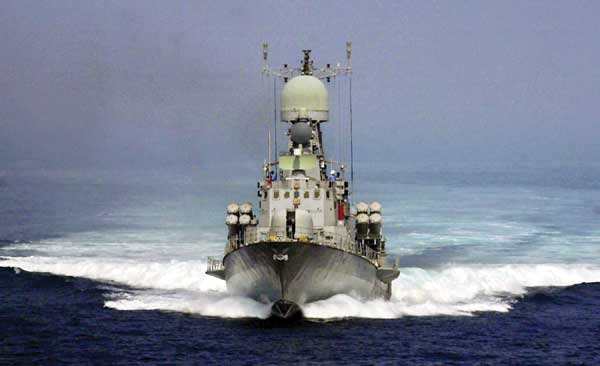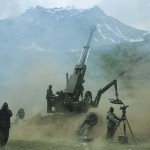“Modernisation” of a Navy is a continuous process – and each major upgradation takes time and needs to be planned well in advance. The “Great White Fleet” which circum-navigated the globe in 1908-09, and announced to the world that the USA had arrived on the world scene, took twenty years to build. It took the FSU, under the dynamic leadership of Admiral of the Fleet Gorshkov, almost 25 years to build the Soviet Navy to a level where it could challenge the western Allies.
The new scourge of terrorism has taken the world by storm. So far major acts of terrorism have by and large been restricted to land areas.
The Indian Navy of 2010-20 is already being built – the Air Defence Ship at Kochi, the Vikramaditya (Ex Gorshkov) at Russia, along with its complement of MiG 29K, the Naval LCA at Bangalore, the Scorpene submarines at MDL, and at last count about 22 Destroyers, Frigates, corvettes, LSTs , OPVs, and FACs at various shipyards around the country. We must, therefore, look at what is needed, and what is possible, for the time frame of 2020-2030, and what else is needed to fill the voids prior to 2020.
In arriving at the final figures we must take into account the probable security challenges and maritime threats that we will need to counter and the maritime interests that we will need to protect, preserve and indeed promote; India’s stature and position in the comity of nations; our economic potential; and finally our design, industrial and ship-building capability. A little “crystal ball gazing” is, therefore, an essential part of the planning process – never an easy thing to do at the best of times.
Security Environment and Challenges
Geo-strategic Location. Geography, they say is the handmaiden of strategy – and geography has indeed been very kind to us. It has bestowed on India many strategic opportunities, options and indeed advantages some of which are:-
- A coastline of 7516 Km, which includes the mainland as also the Island territories.
- 12 major, 21 intermediate and 164 minor ports.
- A total of 1197 Islands, which provide Defence in Depth and also give us a huge EEZ. At 2.01 million sq km our EEZ is 2/3rds of our land area. After demarcation of the continental shelf our EEZ is likely to be 2.54 million sq km.
- A very favourable geo-strategic location astride the vital East-West trade routes, which enables us to control, when necessary, this energy/trade lifeline. Position matters – on land as on the Sea.
- Moreover, the ocean that laps our shores is itself unique. Unlike other oceans, it is not “open-ended”. It is closed to the North by the Indian sub-continent and has a few “choke points” that afford entry into it.
…because the High Seas are unowned, there are No Boundaries at Sea. This is what makes the Navy different to all other Services, which work within the confines of national boundaries. The Navy works in an International arena on a daily basis.
Unregulated Ocean Space. Speaking to the press at Singapore on 12 Nov 2003 I had described the Oceans as “the largest unregulated space in the world”, a quote that has appeared in the editorial of the 2005 edition of “Jane’s Fighting Ships”. As the editorial points out, this may seem strange considering that the UN Convention on the Laws of the Sea is now in place. But the fact is that while the UNCLOS has given various rights to nations, the right to freedom of navigation has not changed, nor have the attributes and essential characteristics of the oceans that constitute 70% of the surface of the globe. These attributes are:-
- Large parts of the Oceans remain Unowned. While nations have sovereign rights over their territorial seas and commercial rights to all the resources in their EEZ, no nation “Owns” the “High Seas”.
- Because the High seas are largely unowned, they are uncontrolled. It’s a case of “No Policeman-No Law”. On the high seas there is nobody, but nobody, to control your movements.
- Because the High Seas are unowned, there are No Boundaries at Sea. This is what makes the Navy different to all other Services, which work within the confines of national boundaries. The Navy works in an International arena on a daily basis. Twelve miles out of port and we are in International waters.
- Because of these attributes of the Oceans, the Sea is One. Thus, all nations with a coastline are maritime neighbours.
Maritime Terrorism. The new scourge of terrorism has taken the world by storm. So far major acts of terrorism have by and large been restricted to land areas. But as security on land is tightened, the ease of access and movement across the world’s ocean areas will tempt terrorists to take their “trade” to sea. The war on terror at sea cannot be fought by individual nations. It will have to be a worldwide effort that will require Navies of the world to work together – as countries are doing ashore.
We declared “No First Use” (NFU) NWS. Any country with an NFU policy must ensure that it has an assured second-strike capability.
Nuclear Backdrop. We are now a declared nuclear weapon state (NWS) and, after some hiccups, the world has accepted this reality. Our nuclear doctrine clearly states that we will maintain a“Credible Minimum Deterrent” based on a triad of weapon delivery systems. We are also a declared “No First Use” (NFU) NWS. Any country with an NFU policy must ensure that it has an assured second-strike capability. Missile silos, airfields and aircraft are easily detected by satellites and are hence easy targets. A nuclear submarine is very, very difficult to detect. Even if detected, it is extremely difficult to target, as it is constantly on the move at speeds of twenty knots or more.
Territorialisation of the Seas. Maritime powers have always wanted (as they still do) as much freedom of the seas, as possible; whereas non-maritime powers want as much ownership of the seas, as possible. With the UNCLOS, both have got much of what they wanted. Almost 40% of the ocean areas have become the Exclusive Economic zones of countries. The full claims for the world’s EEZ have yet to be submitted by many countries and agreed to by the UN, and more important, by neighbouring states. Earlier we had neighbours and boundaries only on land. Now we have them at sea as well. The more the neighbours, the more are the problems. The larger the EEZ, the greater is the area of responsibility of the maritime Services.
Earlier we had neighbours and boundaries only on land. Now we have them at sea as well. The more the neighbours, the more are the problems. The larger the EEZ, the greater is the area of responsibility of the maritime Services.
Global Governance. Globalisation has made countries more inter-dependent and States will increasingly work together to ensure their economic development, as also to promote peace, stability and combat common threats. In future, therefore, one sees a form of “Global Governance” slowly but surely creeping to seaward to ensure that the “Freedom of the Seas”, that the west holds so dear, is not misused by terrorists. The ISPS code, the Container Security Initiative and the Proliferation Security Initiative are manifestations of this trend. This will require the Indian Navy to patrol its area of interest, and work with other Navies, much more than it has done in the past.
Strategic Frontiers. What then is The Indian Navy’s “area of interest”? Our land frontiers are well known. So also are our maritime boundaries with our immediate maritime neighbours. But our current area of interest lies far, far beyond our territorial sea and the EEZ. It extends all the way to the choke points that afford entry into the North Indian Ocean as shown in the map below.
Extra-Regional Presence. Any nation with the capability can traverse the Oceans and arrive in force at the doorstep of another maritime state- no matter how distant it may be. Powerful Navies have indulged in “Gun Boat Diplomacy” in the past. While the phrase may be out of fashion these days, Navies continue to be used for the same purpose, by whatever name it may be called. It is well known that the strategic focus of the world has once again shifted to the North Indian Ocean, due to a combination of Terrorism and world energy reserves. The presence of extra-regional powers in the Indian Ocean is bound to last well into the foreseeable future. The Indian Navy consequently has to operate in the same waters as are being patrolled by the world’s most technologically advanced nations.
…strategic focus of the world has once again shifted to the North Indian Ocean, due to a combination of Terrorism and world energy reserves. The presence of extra-regional powers in the Indian Ocean is bound to last well into the foreseeable future.
Defence of Trade. Trade is the lifeblood of any economy–and so it is with India. Our economy is booming and this trade will continue to soar. Today 90% of the crude oil we use comes from across the oceans – be it imported or produced in our offshore oil fields. Our dependence on natural gas is increasing by the day. Over 95% of our trade by volume comes across the oceans. Any disruption of this trade lifeline, particularly any disruption in the flow of oil, will endanger the economic prosperity and security of the country. Defence of trade has always been a major mission of the Navy and this will continue to be so.
Maritime Diplomacy. The Navy works very closely with the External Affairs Ministry to further the interests of the country around the world. Towards this end it sends ships on overseas deployments to show the flag and build “Bridges of Friendship” – which was also the theme of the Navy’s very successful Inter-national Fleet Review in 2001. Towards this end the Navy also trains a considerable number of foreign Naval personnel in its many training institutions. With many small nations on the Indian Ocean rim now getting huge EEZs there is a growing demand for assistance and suitable vessels to patrol these areas. It is in India’s interest to meet these demands and supply equipment as and when requested. Since many of these countries cannot afford to buy such vessels we must be willing and ready to supply them at short notice, and free of cost. Budgetary provisions must be regularly made for such assistance.
Regional Naval Expansion. The Naval development plans of maritime states in the Asia-Pacific region clearly indicate that all are giving greater importance to maritime security then ever before – a trend that we must take note of.
The Threat. Very often I have been asked to identify the “Threat” that the Indian Navy is going to face. The immediate threat is well known, but I have always desisted from identifying others because “to name an enemy is to make one”. But more important is the fact that in this respect the Navy has to think and plan differently than the other two services, which can clearly identify the threat across our borders. Because of the unregulated ocean space, ease of access and movement a threat can develop from the sea very quickly. So, unlike the other two Services,Navies are not built purely to counter known threats but to protect maritime interests. The larger a country’s dependence on the oceans, and the larger its interests at sea, the larger its Navy has got to be.






Wapelere http://paydayloanse.loan
Excellent.Hope the points made herein were duly taken note of by the GOI